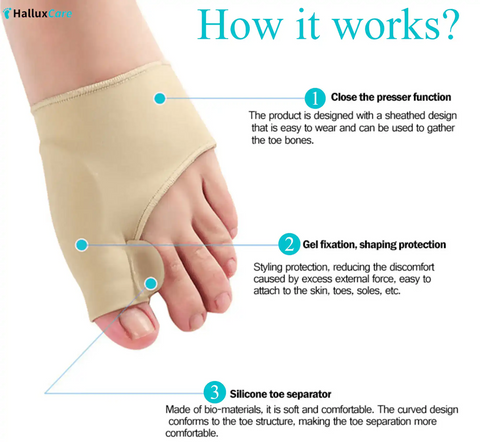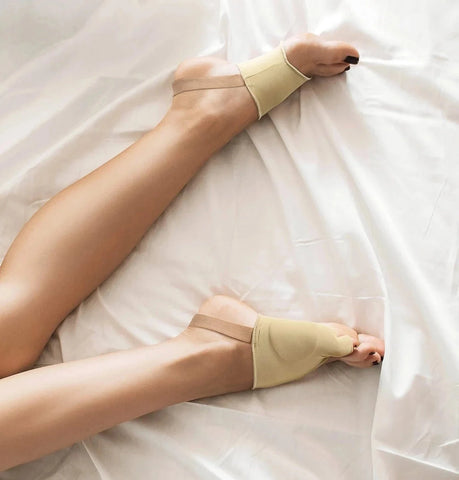Understanding Midfoot vs. Big Toe Joint Fusions: Lapidus and MTP Explained
Last updated: 2025-11-16T04:13:29.597Z
Author: Dr. Emily Harper, DPM – Board-Certified Podiatrist
Key Takeaways: What You Need to Know About Foot Joint Fusions
- Lapidus fusion stabilizes the midfoot (TMT joint) and maintains foot flexibility.
- MTP fusion fuses the big toe joint, eliminating toe bending and impacting walking mechanics.
- Surgery choice depends on bunion severity, pain, and lifestyle goals.
- Orthopedic bunion sleeves and protective gear offer effective non-surgical symptom relief.
- Proper footwear and exercises support bunion management and recovery.
What is a Bunion (Hallux Valgus) and Bunionette (Tailor’s Bunion)?
A bunion (hallux valgus) is a bony bump at the base of the big toe caused by misalignment of the joint. It often leads to pain, swelling, and difficulty wearing shoes. A bunionette or tailor’s bunion occurs on the outside of the foot, affecting the little toe joint, causing similar discomfort.
The Lapidus and MTP Joints: Anatomy and Function
Lapidus Joint (Tarsometatarsal Joint)
- Located in the midfoot where the first metatarsal meets the tarsal bones.
- Primarily allows limited gliding motion, not bending.
- Critical for foot stability during walking and weight-bearing.[1]
MTP Joint (Metatarsophalangeal Joint)
- Connects the metatarsal bone to the big toe’s proximal phalanx.
- Enables bending of the big toe, essential for push-off in walking and running.
- Common site for bunion deformities.[2]
Lapidus Fusion vs. MTP Fusion: Detailed Differences
Lapidus Fusion (TMT Joint Fusion)
- Purpose: Stabilizes the midfoot, usually for severe bunions or midfoot instability.
- Mobility: Fusion does not restrict toe bending since the joint is a gliding joint.
- Recovery: Most patients notice little change in foot flexibility, but gain stability.[3]
- Benefit: Reduces bunion recurrence and improves foot function long-term.
MTP Fusion (Big Toe Joint Fusion)
- Purpose: Used for severe arthritis or bunion deformities to eliminate pain by fusing the big toe joint.
- Mobility: Stops big toe bending, restricting push-off during gait.
- Recovery: Patients need to adapt to altered walking patterns but often experience significant pain relief.[4]
- Consideration: Best suited for patients prioritizing pain control over toe flexibility.
Symptoms and When to Seek Medical Care for Bunions
Common bunion symptoms include:
- Persistent pain and swelling around the big toe joint.
- Difficulty wearing certain shoes, especially narrow or high heels.
- Visible bump on the side of the foot.
- Reduced toe movement.[5]
Seek podiatric care if pain limits daily activities or worsens despite conservative treatment.
Conservative Bunion Management and Product Use Guidance
Before surgery, or as part of ongoing care, conservative options help manage symptoms:
- Orthopedic bunion sleeves: Provide cushioning and gentle toe realignment to reduce pressure and pain.
- Toe spacers: Help separate toes, relieving crowding and preventing worsening of bunions.[6]
- Bunion pads and splints: Protect against friction and correct mild deformities.
Using these products consistently, especially in combination with proper footwear, can delay or sometimes avoid surgery.
Fit and Footwear Tips for Bunion Comfort
Proper footwear is key to managing bunions and preventing progression:
- Wide toe box: Allows toes to spread naturally without pressure.
- Soft, flexible materials: Minimize irritation and friction.
- Low heel height (less than 2 inches): Reduces forefoot pressure.[7]
- Adjustable closures: Help accommodate foot shape changes and swelling.
Avoid tight, pointed, or high-heeled shoes that aggravate bunion pain.
Exercises and Daily Routines for Bunion Care
Incorporate simple exercises to maintain foot flexibility and reduce discomfort:
- Toe stretches and spreads: Strengthen muscles and maintain joint mobility.
- Big toe flexion and extension: Keep the MTP joint mobile if not fused.
- Foot rolling: Massage the arch to relieve tension.
Regular activity and foot care can improve circulation and reduce stiffness.[8]
How to Use Orthopedic Bunion Sleeves and Supports
- Clean and dry your foot before application.
- Slide the sleeve over your big toe and position the padding over the bunion area.
- Wear sleeves during daily activities or as recommended by your podiatrist.
- Combine with proper footwear for maximum comfort.
- Replace sleeves regularly to maintain hygiene and effectiveness.
4.9 ⭐⭐⭐⭐⭐ ( 1843 reviews )
FAQs About Bunions, Joint Fusions, and Orthopedic Supports
Are toe spacers safe for bunions?
Yes, toe spacers can be safe and effective to reduce toe crowding and ease bunion pain when used correctly. They help realign toes and prevent worsening deformities but should be used as part of a comprehensive care plan.[6]
How long should I wear toe spacers daily?
Start with short periods (30 minutes to 1 hour) and gradually increase to several hours daily as tolerated. Consistency matters, but avoid overuse to prevent discomfort.
Bunion vs. tailor’s bunion – what’s the difference?
A bunion affects the big toe joint (hallux valgus), while a tailor’s bunion (bunionette) affects the little toe side. Both cause painful bumps but appear on opposite sides of the foot.
Do bunion sleeves help with shoe comfort?
Yes, bunion sleeves cushion the affected area, reduce friction, and can gently support toe alignment, improving comfort inside shoes.
When should I see a podiatrist?
Seek medical advice if bunion pain limits walking, causes swelling, or worsens despite home care. Early evaluation helps prevent progression and guides treatment.
Can I run or play pickleball with a bunion?
With mild bunions and proper footwear, many can continue activities like running or pickleball. Use orthopedic supports and select shoes with wide toe boxes to minimize discomfort.
Join the Conversation
Have you undergone Lapidus or MTP fusion? Or used orthopedic sleeves for bunion pain? Share your experiences below — your insights can help others navigate their foot health journey.
Glossary
- Bunion (Hallux Valgus): A deformity at the big toe joint causing a bony bump.
- Bunionette (Tailor’s Bunion): Similar bump on the outside of the foot near the little toe.
- Toe Spacers: Devices that separate toes to reduce crowding.
- Bunion Sleeves: Soft supports that cushion and protect the bunion area.
- Orthoses: Custom or off-the-shelf devices to support foot alignment.
Sources
- American Orthopaedic Foot & Ankle Society (AOFAS). "Tarsometatarsal (TMT) Joint." https://www.aofas.org/
- MedlinePlus. "Bunion." https://medlineplus.gov/ency/article/001134.htm
- Cochrane Review. "Lapidus Procedure for Hallux Valgus Correction," 2020.
- National Institutes of Health (NIH). "Metatarsophalangeal Joint Arthritis," 2021.
- American Podiatric Medical Association (APMA). "Bunion Symptoms and Treatment." https://www.apma.org/
- NCBI.




